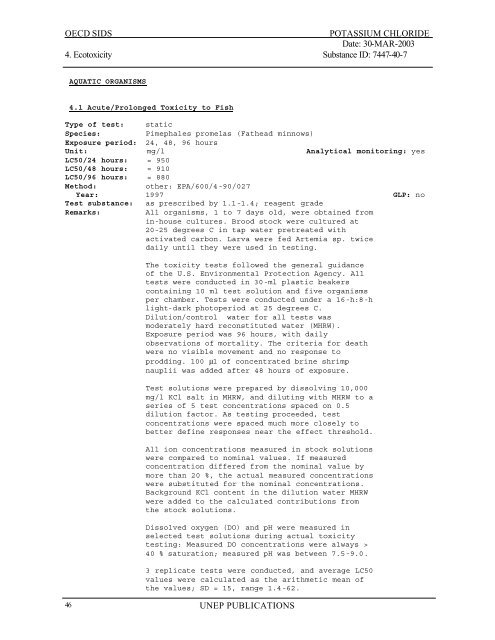POTASSIUM CHLORIDE CAS N°: 7447-40-7
POTASSIUM CHLORIDE CAS N°: 7447-40-7
POTASSIUM CHLORIDE CAS N°: 7447-40-7
You also want an ePaper? Increase the reach of your titles
YUMPU automatically turns print PDFs into web optimized ePapers that Google loves.
OECD SIDS<br />
<strong>POTASSIUM</strong> <strong>CHLORIDE</strong><br />
Date: 30-MAR-2003<br />
4. Ecotoxicity Substance ID: <strong>7447</strong>-<strong>40</strong>-7<br />
AQUATIC ORGANISMS<br />
4.1 Acute/Prolonged Toxicity to Fish<br />
Type of test: static<br />
Species:<br />
Pimephales promelas (Fathead minnows)<br />
Exposure period: 24, 48, 96 hours<br />
Unit: mg/l Analytical monitoring: yes<br />
LC50/24 hours: = 950<br />
LC50/48 hours: = 910<br />
LC50/96 hours: = 880<br />
Method:<br />
other: EPA/600/4-90/027<br />
Year: 1997 GLP: no<br />
Test substance: as prescribed by 1.1-1.4; reagent grade<br />
Remarks:<br />
All organisms, 1 to 7 days old, were obtained from<br />
in-house cultures. Brood stock were cultured at<br />
20-25 degrees C in tap water pretreated with<br />
activated carbon. Larva were fed Artemia sp. twice<br />
daily until they were used in testing.<br />
The toxicity tests followed the general guidance<br />
of the U.S. Environmental Protection Agency. All<br />
tests were conducted in 30-ml plastic beakers<br />
containing 10 ml test solution and five organisms<br />
per chamber. Tests were conducted under a 16-h:8-h<br />
light-dark photoperiod at 25 degrees C.<br />
Dilution/control water for all tests was<br />
moderately hard reconstituted water (MHRW).<br />
Exposure period was 96 hours, with daily<br />
observations of mortality. The criteria for death<br />
were no visible movement and no response to<br />
prodding. 100 µl of concentrated brine shrimp<br />
nauplii was added after 48 hours of exposure.<br />
Test solutions were prepared by dissolving 10,000<br />
mg/l KCl salt in MHRW, and diluting with MHRW to a<br />
series of 5 test concentrations spaced on 0.5<br />
dilution factor. As testing proceeded, test<br />
concentrations were spaced much more closely to<br />
better define responses near the effect threshold.<br />
All ion concentrations measured in stock solutions<br />
were compared to nominal values. If measured<br />
concentration differed from the nominal value by<br />
more than 20 %, the actual measured concentrations<br />
were substituted for the nominal concentrations.<br />
Background KCl content in the dilution water MHRW<br />
were added to the calculated contributions from<br />
the stock solutions.<br />
Dissolved oxygen (DO) and pH were measured in<br />
selected test solutions during actual toxicity<br />
testing: Measured DO concentrations were always ><br />
<strong>40</strong> % saturation; measured pH was between 7.5-9.0.<br />
3 replicate tests were conducted, and average LC50<br />
values were calculated as the arithmetic mean of<br />
the values; SD = 15, range 1.4-62.<br />
46<br />
UNEP PUBLICATIONS
















